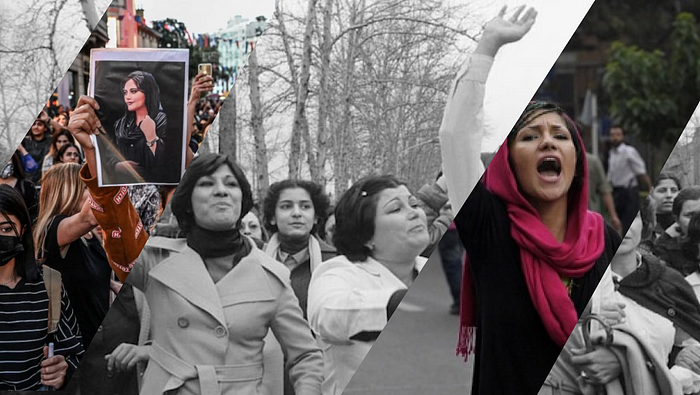

A human rights crisis: the role of social media UX in social injustice in Iran
source link: https://uxdesign.cc/a-human-rights-crisis-the-role-of-social-media-ux-in-social-injustice-in-iran-9fea994be35c
Go to the source link to view the article. You can view the picture content, updated content and better typesetting reading experience. If the link is broken, please click the button below to view the snapshot at that time.
A human rights crisis: the role of social media UX in social injustice in Iran
Protests have erupted across Iran and outside the country after the death ofMahsa Amini, a 22-year-old Iranian who was killed by morality police earlier this month. While the Iranian government started shutting down the internet in most cities and blocked social media apps, including but not limited to Skype and WhatsApp, one could not oversee the restrictive role of social media UX in contributing to censorship. Despite their mission statements and instead of bringing visibility to the injustice, some of the major social media applications have been designed to silence the victims and erase their stories.

Mahsa Amini’s illustration made by ux.sayena
Why should we talk about this?
I can spend the entire story discussing the brutal death of Mahsa Amini, a 22-year old girl who was visiting Tehran with her family, or the shameful aftermath of inviting the Iranian president to the UN, while the main voice that needed to be broadcasted belonged to the Iranian women fighting for their rights on the streets. Not even a book would be enough to discuss the death of young Iranian protestors (including Sarina Esmailzadeh and Nika Shakarami, both 16-year old young women full of dreams and passions). However, it is our responsibility to once again, bring light and visibility to the restrictive and destructive social media applications that were originally designed to bring the global world closer, connect people, and be the voice of those in need.

An Iranian/women protestor at UN instead of the Iran’s president, made by ux.sayen
Social media UX and attention economy
To understand the role of UX in social media design, you need to look behind multiple layers of design strategy. A lot of what makes social media attractive, engaging, and addictive is from how these applications look and feel, and are deeply rooted in our understanding of human behavior and UX.
On February 9, 2009, Facebook introduced the like button. Initially, the button was an innocent thing. It had nothing to do with hijacking the social reward systems of a user’s brain. Today, most of us reach for Snapchat, Instagram, Facebook, or Twitter with one vague thought in mind: Maybe someone liked my stuff. And it’s this craving for validation, experienced by billions around the globe, that’s currently pushing platform engagement in ways that in 2009 were unimaginable. But more than that, it’s driving profits to levels that were previously impossible. [From “Your Addiction to Social Media Is No Accident”]
“The attention economy” describes the supply and demand of a person’s attention, which is the commodity traded on the internet. The business model is simple: The more attention a platform can pull, the more effective its advertising space becomes, allowing it to charge advertisers more.
Facebook ‘like’ emoji, Facebook headquarters in Menlo Park, CA.
Social media UX and politics
Similar to how the attention economy drives many of the features, algorithms, and the core experiences that drive engagement on social media, politics and profit drive a major role in business strategy and content moderation.
Commissioned by Meta in 2021, the independent consultancy Business for Social Responsibility, or BSR, conducted a study on the company’s censorship practices and bias during bouts of violence against Palestinian people by Israeli forces during May 2021.
What did the report find?
According to the findings of BSR’s report, Meta deleted Arabic content relating to the violence at a far greater rate than Hebrew-language posts, confirming long-running complaints of disparate speech enforcement in the Palestinian-Israeli conflict. Facebook and Instagram have wrongfully removed and suppressed content by Palestinians and their supporters, including about human rights abuses carried out in Israel and Palestine.
Artwork on the wall that separating Israel and Palestine saying “caution, children are playing”.
The report concludes with a list of 21 nonbinding policy recommendations, including increased staffing capacity to properly understand and process non-English posts, and increased company oversight of outsourced moderators.
In its response to the report, Meta vaguely committed to implement or consider implementing aspects of 20 out of 21 the recommendations.
Iranian protests and bias in content moderation
“Today my video with 2 million views supporting the people of Iran was removed from Instagram. Not only that, my ability to appeal was removed and to share video content.” Emily Schrader, an Israeli journalist, writer, social activist, entrepreneur, and digital marketing expert said in her video posted on TikTok and Instagram on September 2022.
Despite Meta’s commitment, Iran protests and the bias in content moderation on its social media applications demonstrated that once again, the company is far away from concluding its censorship.
Platforms that were once designed to “to capture and share the world’s moments (Instagram mission statement)” and “to give people the power to share and make the world more open and connected (Facebook mission statement)” have becomepowerful tools to silence unprivileged people and censor the violence against them. These tools that are designed based on high-quality standards to drive engagement have been proven to disconnect those in need from the world and erase their stories.
What can we do?

Iranian women protesting for their rights for over 43 years since Islamic revolution.
The women-led revolution in Iran will continue to evolve and rise wether the western countries, social media platforms, and politicians join it or not. What can no longer be hidden is the role of social media in creating an uneven competition and silencing the voices. We are the designers and professionals working on products that might directly or indirectly be used for good and bad purposes. We are the bricks that would create these experiences for millions of users and individuals that can hold these companies accountable for their actions. Beyond designers, we are responsible for the future generations of people who will continue to live on this planet after we’re gone. It is our duty to be part of business strategies, design operations, and user experiences that make the world a better place.
- Learn more about the ethics of your products, the limits that it creates, as well as the opportunities that it drives. You are not just a machine in the system, you are an individual with intelligence and feelings. Then create products and experiences with intelligence and feelings.
- Contact your representatives, ask them to investigate this matter, and get involved. This is a violation of human rights. As history has shown, companies like Meta continue to apply the same censorship during the times when they’re most needed.
- Spread the words. Hold these companies accountable for their violations of human rights. Do not let them silence those in need.
Recommend
About Joyk
Aggregate valuable and interesting links.
Joyk means Joy of geeK